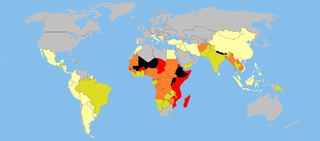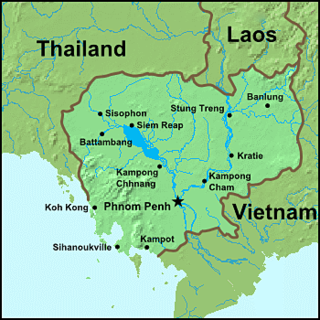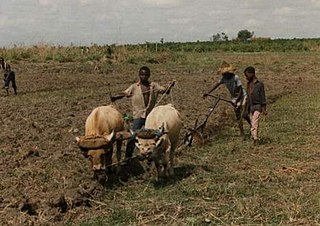
Child labour refers to the exploitation of children through any form of work that deprives them of their childhood, interferes with their ability to attend regular school, and is mentally, physically, socially and morally harmful. Such exploitation is prohibited by legislation worldwide, although these laws do not consider all work by children as child labour; exceptions include work by child artists, family duties, supervised training, and some forms of work undertaken by Amish children, as well as by indigenous children in the Americas.

A child is a human being between the stages of birth and puberty, or between the developmental period of infancy and puberty. The legal definition of child generally refers to a minor, otherwise known as a person younger than the age of majority. Children generally have fewer rights and responsibilities than adults. They are classed as unable to make serious decisions.

Child marriage is a marriage or similar union, formal or informal, between a child under a certain age – typically 18 years – and an adult or another child. The vast majority of child marriages are between a female child and a male adult, and are rooted in gender inequality.
Child labour in Botswana is defined as the exploitation of children through any form of work which is harmful to their physical, mental, social and moral development. Child labour in Botswana is characterised by the type of forced work at an associated age, as a result of reasons such as poverty and household-resource allocations. child labour in Botswana is not of higher percentage according to studies. The United States Department of Labor states that due to the gaps in the national frameworks, scarce economy, and lack of initiatives, “children in Botswana engage in the worst forms of child labour”. The International Labour Organization is a body of the United Nations which engages to develop labour policies and promote social justice issues. The International Labour Organization (ILO) in convention 138 states the minimum required age for employment to act as the method for "effective abolition of child labour" through establishing minimum age requirements and policies for countries when ratified. Botswana ratified the Minimum Age Convention in 1995, establishing a national policy allowing children at least fourteen-years old to work in specified conditions. Botswana further ratified the ILO's Worst Forms of Child Labour Convention, convention 182, in 2000.
Child labour in Eswatini is a controversial issue that affects a large portion of the country's population. Child labour is often seen as a human rights concern because it is "work that deprives children of their childhood, their potential and their dignity, and that is harmful to physical and mental development," as defined by the International Labour Organization (ILO). Additionally, child labour is harmful in that it restricts a child's ability to attend school or receive an education. The ILO recognizes that not all forms of children working are harmful, but this article will focus on the type of child labour that is generally accepted as harmful to the child involved.

Human rights in Bangladesh are enshrined as fundamental rights in Part III of the Constitution of Bangladesh. However, constitutional and legal experts believe many of the country's laws require reform to enforce fundamental rights and reflect democratic values of the 21st century. Proposed reforms include strengthening parliamentary supremacy, judicial independence, the separation of powers, repealing laws which restrain freedom of the press and disbanding security agencies which violate civil liberties.

The status of women in Bangladesh has been subject to many important changes over the past few centuries. Bangladeshi women have made significant progress since the country's independence in 1971, where women in the region experienced increased political empowerment for women, better job prospects, increased opportunities of education and the adoption of new laws to protect their rights through Bangladesh's policies in the last four decades. Still, women in Bangladesh continue to struggle to achieve equal status to men due to societal norms that enforce restrictive gender roles as well as poor implementation of laws that were set to protect women.

Child labour in Bangladesh is common, with 4.7 million children aged 5 to 14 in the work force. Out of the child labourers engaged in the work force, 83% are employed in rural areas and 17% are employed in urban areas. Child labour can be found in agriculture, poultry breeding, fish processing, the garment sector and the leather industry, as well as in shoe production. Children are involved in jute processing, the production of candles, soap and furniture. They work in the salt industry, the production of asbestos, bitumen, tiles and ship breaking.

A significant proportion of children in India are engaged in child labour. In 2011, the national census of India found that the total number of child labourers, aged [5–14], to be at 10.12 million, out of the total of 259.64 million children in that age group. The child labour problem is not unique to India; worldwide, about 217 million children work, many full-time.

India has a very high volume of child trafficking. As many as one child disappears every eight minutes, according to the National Crime Records Bureau. In some cases, children are taken from their homes to be bought and sold in the market. In other cases, children are tricked into the hands of traffickers by being presented an opportunity for a job, when in reality, upon arrival they become enslaved. In India, there are many children trafficked for various reasons such as labor, begging, and sexual exploitation. Because of the nature of this crime; it is hard to track; and due to the poor enforcement of laws, it is difficult to prevent. Due to the nature of this crime, it is only possible to have estimates of figures regarding the issue. India is a prime area for child trafficking to occur, as many of those trafficked are from, travel through or destined to go to India. Though most of the trafficking occurs within the country, there is also a significant number of children trafficked from Nepal and Bangladesh. There are many different causes that lead to child trafficking, with the primary reasons being poverty, weak law enforcement, and a lack of good quality public education. The traffickers that take advantage of children can be from another area in India, or could even know the child personally. Children who return home after being trafficked often face shame in their communities, rather than being welcomed home.
Child labour in Pakistan is the employment of children to work in Pakistan, which causes them mental, physical, moral and social harm. Child labour takes away the education from children. The Human Rights Commission of Pakistan estimated that in the 1990s, 11 million children were working in the country, half of whom were under age ten. In 1996, the median age for a child entering the work force was seven, down from eight in 1994. It was estimated that one quarter of the country's work force was made up of children.

Child labour refers to the full-time employment of children under a minimum legal age. In 2003, an International Labour Organization (ILO) survey reported that one in every ten children in the capital above the age of seven was engaged in child domestic labour. Children who are too young to work in the fields work as scavengers. They spend their days rummaging in dumps looking for items that can be sold for money. Children also often work in the garment and textile industry, in prostitution, and in the military.

The incidence of child labour in Nepal is relatively high compared with other countries in South Asia. According to the Nepal Labour Force Survey in 2008, 86.2% of children who were working were also studying and 13.8% of the children were working only.
According to UNICEF, child marriage is the "formal marriage or informal union before age 18," and it affects more girls than boys. In Afghanistan, 57% of girls are married before they are 19. The most common ages for girls to get married are 15 and 16. Factors such as gender dynamics, family structure, cultural, political, and economic perceptions/ideologies all play a role in determining if a girl is married at a young age.

Child labour in Africa is generally defined based on two factors: type of work and minimum appropriate age of the work. If a child is involved in an activity that is harmful to his/her physical and mental development, he/she is generally considered as a child labourer. That is, any work that is mentally, physically, socially or morally dangerous and harmful to children, and interferes with their schooling by depriving them of the opportunity to attend school or requiring them to attempt to combine school attendance with excessively long and heavy work. Appropriate minimum age for each work depends on the effects of the work on the physical health and mental development of children. ILO Convention No. 138 suggests the following minimum age for admission to employment under which, if a child works, he/she is considered as a child laborer: 18 years old for hazardous works, and 13–15 years old for light works, although 12–14 years old may be permitted for light works under strict conditions in very poor countries. Another definition proposed by ILO's Statistical Information and Monitoring Program on Child Labor (SIMPOC) defines a child as a child labourer if he/she is involved in an economic activity, and is under 12 years old and works one or more hours per week, or is 14 years old or under and works at least 14 hours per week, or is 14 years old or under and works at least one hour per week in activities that are hazardous, or is 17 or under and works in an "unconditional worst form of child labor".

Armenia was admitted into the United Nations on 2 March 1992, following its independence from the Soviet Union. In December 1992, the UN opened its first office in Yerevan. Since then, Armenia has signed and ratified several international treaties. There are 20 specialized agencies, programs, and funds operating in the country under the supervision of the UN Resident Coordinator. Armenia strengthened its relations with the UN by cooperating with various UN agencies and bodies such as the International Monetary Fund, the World Bank, the World Food Programme, and with the financial institutions of the UN. Armenia is a candidate to preside as a non-permanent member of the UN Security Council in 2031.

Child marriage is a marriage or union between a child under the age of 18 to another child or to an adult. Child marriage is common in a multitude of African countries. In South Sudan, child marriage is a growing epidemic. Child marriage in South Sudan is driven by socioeconomic factors such as poverty and gender inequality. Current figures state that South Sudan is one of the leading countries in the world when it comes to child marriage. Child marriage has negative consequences for children, including health problems and lower education rates for South Sudanese girls. Many initiatives have been taken to combat child marriage in South Sudan but the presence of societal norms and instability continues to drive its presence in the nation.
UNICEF's Early Marriage: A Harmful Traditional Practice report characterizes child marriage as a harmful institution that often exposes young women in developing nations to damaging domestic, health, and sexual conditions. The report also highlights the practice as a human rights violation. In World Vision's "Before She's Ready: 15 Places Girls Marry by 15," the organization highlights the socioeconomic consequences of child marriage on girls, noting that many girls are forced to stop their schooling as a result of their marriages. With the denial of education, girl brides are often not able to make income as adults or become politically active citizens.
The haruwa–charuwa system is a forced-labour system based on debt bondage, prevalent in the agricultural sector of the eastern Terai region in Nepal. Haruwa means "forced tiller" and are usually adult males, while charuwa means "forced cattle-herder" and are usually women and children. The victims of this bonded labour system are usually dalit families, most commonly from the Musahar caste. Due to landlessness and poverty, they are forced into service of landowner families under slavery-like conditions. The haruwa–charuwa system is similar to the Haliya and Kamaiya systems of western Nepal.

India is the second most populated country in the world with nearly a fifth of the world's population. According to the 2022 revision of the World Population Prospects the population stood at 1,407,563,842.

















